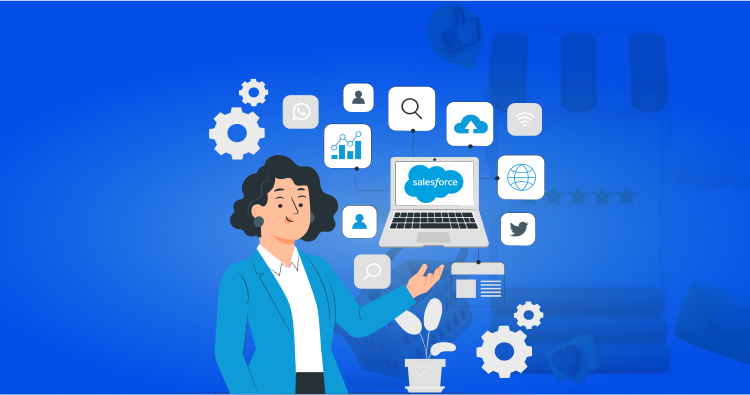Commerce Cloud Salesforce has always been a vigorous, strong, scalable, cloud-based solution. The acquisition of CloudCraze by Salesforce in April 2020 transformed the commerce cloud into a far more powerful platform with the Salesforce B2B Commerce Integration.
Businesses can now provide individualised purchasing experiences to their customers’ thanks to the changes.
Customers receive a smooth, uniform experience across all the touchpoints available, including mobile, web, social, and physical. The Salesforce future is even brighter than you can imagine.
Salesforce’s business benefits, use cases across industries, and an Endeavour to draw you closer to the platform, which is something more than just a CRM, it is a Saas platform with all cloud capabilities.
Organizations in the post-pandemic era require technologies that promote collaboration, provide a linked and personalized experience, and make work simple from anywhere.
As a result, Salesforce goods that successfully meet the criteria for it to be famous in the current year, topping the lists. Year after year, the platform has risen by leaps and bounds, and the Salesforce future will continue to be relevant and in demand.
Questions about scaling commerce? Read this article Salesforce eCommerce integration to have a better understanding of the topic.
Is Salesforce Commerce Cloud Still in Demand in 2022
Since its beginning, Salesforce has continued to remain relevant. With the rise of remote labour, more businesses are turning to digital selling to keep afloat. Salesforce is being used more frequently to aid the remote sales crew.
Salesforce anywhere allows users to sell from anywhere in the world with ease. Salesforce also released Sales Cloud 360 in March 2021, in line with the digital-first strategy, to enable digital selling and boost remote sales performance and it also offers Salesforce B2C Commerce.
Salesforce has also boosted collaboration by combining technologies like Quip, Salesforce Meetings, and Salesforce Anywhere, as well as acquiring Slack.
This product offering adds value to Salesforce customers and has led to an increase in demand which raises the bar for Salesforce future to a higher level.
Here are the top Salesforce Commerce Cloud trends that will help businesses keep up with all the latest Salesforce future developments.
Questions? Ask about Salesforce Commerce Cloud pricing, implementation, or anything else. Also, Read this Guide What Is Salesforce Commerce Cloud?
MAJOR TRENDS THAT ARE CHANGING THE FACE OF THE SALESFORCE INDUSTRY
-
Slack
Slack First Customer 360 will make it much easier for enterprises to transition to a hybrid work culture in 2022.
Salesforce bought Slack, and the merged company now allows teams to remain connected, productive, and get work done from anywhere, all while having a single version of the truth for their business and a single shared perspective of the customer.
With Slack First Customer 360, you can now complete more transactions, resolve tickets faster, manage campaigns more effectively, and gain sophisticated AI-driven insights on customer data.
Every team whether it’s sales, service, or marketing would be able to communicate through channels that link employees and streamline workflows built around its data thanks to the new pre-made integration.
-
Biggest year Of Data And System Integration
Customers have grown to anticipate integrated and seamless experiences based on the information they offer across several touchpoints (social media, physical forms, phone assistance, and so on).
Only half of firms, according to the newest Salesforce Connected Customer survey, can adapt their engagement based on previous encounters.
Because data now sits on numerous clouds, and many firms connect Salesforce to off-platform technologies, this is the case.
As a result, sales, service, and marketing teams find themselves scrambling to understand and engage with their clients.
Salesforce is constantly improving its Customer 360 customer data platform to enable enterprises to create such data-driven, tailored experiences.
The platform integrates Commerce Cloud, Marketing Cloud, and Service Cloud to provide a unified view of the customer’s experience with the company.
Customer 360, in conjunction with MuleSoft Inc’s web-based integration platform (bought by Salesforce in 2018), assists businesses in making better decisions and delivering contextualised and personalised experiences.
The most recent updates will enable additional data integration and consent management, as well as advanced audience segmentation and other features.
Read: How to Boost Performance Salesforce Commerce Cloud
Despite all of these efforts, unlocking fragmented data and creating a fully integrated user experience across all channels may take some time.
However, a Salesforce product strategy centred on integration has the opportunity to generate a future manner in which enterprises obtain a 100 percent or more return on investment from their CRM products.
Digital Adoption Platforms are increasingly being used by businesses to integrate multiple sales systems.
DAPs connect not just Salesforce Clouds, but also other CRM systems –Apttus, CLM –Icertis, End-User Collaboration –SharePoint, Sales Performance Management –SAP Callidus Cloud, ERP/Invoice & Expense –Oracle, and Human Capital Management –SAP, Workday.
Finally, organisations will only be able to create a connected consumer experience if they provide merchants with a flawless unified online sales experience.
-
Hyperforce Customization
The marketing team can customize using the Salesforce commerce cloud. Salesforce commerce cloud development allows companies to connect with their customers.
They may offer one-of-a-kind, personalised purchasing experiences on the web, mobile, social media, and in-store.
Every Salesforce commerce cloud release makes it easier for users to personalise the look and feel of their online store. The latest customisable storefront themes allow each user to have their own unique look and feel.
The new ‘Page Designer‘ tool is designed to meet the demands of speed. Without professional assistance, marketers may develop, schedule, and publish pages on the go. The application provides:
- Drag-and-drop interface for quickly adding components and publishing pages. No coding is required.
- Custom elements for campaigns, seasonal promotions, and other unique business requirements
- For the best impression, you can preview the webpage in several device screen modes.
- Ability to plan the release of website material on particular pages by day, time, customer group, and location.
- Any page or feature from any eCommerce website can be reused anywhere.
-
Flow orchestrator
Reducing gaps between distinct stages of workflow has gotten more difficult as teams have become more distributed, and any delays result in lower productivity, lower customer satisfaction, and financial loss.
The secret sauce for swiftly configuring, deploying, and maintaining complicated and flawless corporate workflows is a flow orchestrator.
To maximise user experience, it creates multi-user, multi-step automated business processes with clicks rather than code.
Flow Orchestrator may bridge the large gap in corporate workflows by arranging various flows into steps and multiple steps into stages, resulting in greater performance, customer satisfaction, and money.
-
Steady Enterprise Mobility
By 2020, Gartner expects that 40% of sales companies will use mobile technologies for the majority of their SFA. Salesforce has been at the forefront of the smartphone revolution since 2007, introducing CRM to mobile devices. Salesforce has, in retrospect, building a good platform for future methods.
It’s also encouraging consumers to use the mobile UI with new features like:
- Native app development: In 2018, Salesforce teamed up with Apple (the world’s most advanced mobile operating system) to reimagine the native Salesforce app. The main focus remains the improvement in the UX by leveraging iOS features like Siri Shortcuts, Face ID, and Business Chat.
- Democratizing Salesforce app creation: The Salesforce platform was also named the Leader in the 2020 Magic Quadrant for Enterprise Low-Code Application Platforms, owing to its user-friendly point-and-click app development capabilities. Salesforce understands the value of providing Mobile Builders, a “low-code development environment” with pre-built JavaScript components, to Salesforce developers.
Without any prior training, Salesforce admins and owners can instantly convert spreadsheets into apps with only a few clicks. Folio3 may be able to assist users in navigating such development platforms.
You can use a Folio3-powered stage process and interactive guide to train staff on a live Mobile Builder platform so they’re ready to use those features in the flow of work/development.
-
Blockchain
Companies can construct blockchain networks, workflows, and apps by marrying the power of Salesforce Lightning with Blockchain – a cornerstone for the digital era.
Blockchain can be ustilised by businesses and companies throughout the different industries for asset monitoring, credentialing, verification, and authentication of their items.
-
Industry Genre Specific CRM Solutions
Salesforce is widely utilised in fiscal services and solutions, manufacturing, media, and retail.
And the cloud-based software company has declared unequivocally that it will concentrate its efforts on specific industrial verticals in order to provide more specialised solutions that address their unique difficulties.
The CRM behemoth wants to add a layer of industry-based depth to its CRM and cloud skills.
Salesforce has been releasing updates to the Salesforce Financial Service Cloud that would help unify customer experiences, with the goal of expanding its hold on specific industries.
With the unveiling of its Health Cloud at the DreamForce convention in 2018, the CRM solution business has begun to strengthen its importance in the healthcare market.
Salesforce AppExchange also provides a growing selection of ready-to-install apps, solutions, and consultants, allowing customers to extend to any industry which speaks a lot of Salesforce future.
-
AI Driven Inteligence
AI-based Salesforce Einstein enables computers to forecast human behaviour based on accurate facts and data.
Because customer data has become increasingly crucial for enterprises, Salesforce Einstein powered by Tableau successfully anticipates consumer habits and provides data sets and business insight to make informed business decisions.
Here are some notable events that have occurred since then that demonstrate Salesforce’s concern for AI and data analytics:
- Tableau Software acquisition: Salesforce’s acquisition of Tableau Software, the leading business intelligence or BI and analytics firm, was an unusual and well-publicized move. When one considers the future of data analytics in boosting sales targets, this is extremely interesting stuff.
- Einstein Voice: Einstein Voice –a voice assistant, was introduced in 2018. Customers can command Einstein AI to update Salesforce data and create tasks using machine learning and natural language processing, the voice commands.
- Facilitating the growth of third-party technologies: Several Salesforce AppExchange partners are being encouraged to create products that increase Einstein’s value proposition and, as a result, sales, marketing, and service efficiencies. These investments demonstrate the importance of establishing strong links between CRM and AI in order to undermine sales and other business processes.
-
Skyrocketing Demand For Salesforce Experts
Hundreds of novel features are offered to Salesforce users three times a year during seasonal releases. As a result, developers and users must constantly reskill in order to stay up with the rate of change.
Indeed, a recent IDC report predicts a significant surge in new employment requiring Salesforce skills between 2016 and 2022.
While new personnel can fill this need, bringing them on board and training them from the ground up can be costly. Folio3’s in-app training can help with this.
Folio3 helps employees absorb software changes quickly and retain production in the face of new software releases by providing interactive instructions and contextual guidance. It also automates the generation of training content.
Folio3 thus aids in the democratisation of Salesforce abilities without expending excessive expenditures on training.
-
Better Agility and Flexibility With Headless Architecture
The current business climate is dynamic. Only businesses that can deal with uncertainty and adapt to new situations will succeed.
Customers appreciate businesses that are proactive in responding to shifting demands. The list includes agile businesses.
Headless architecture is a significant driver of commerce cloud agility. It allows for flexibility without increasing risk or cost. Business users can create consistent experiences across all engagement channels with ease.
Back-end services and the front-end customer experience are separated by Salesforce’s scalable commerce APIs.
Businesses, such as eCommerce stores on can select the most appropriate storefront for their needs and objectives. They may construct their headless storefront like follows:
- Using any front-end framework, start from scratch using the commerce APIs.
- Using Managed Runtime with the Progressive Web App (PWA) Kit The PWA Kit includes elements and eCommerce flow with best practices built-in. Businesses can use a custom-built storefront to save money, time, and resources. The web experience for users is current and entirely customisable. Managed Runtime securely hosts shops and allows for easy scaling. Instead of wasting time and energy on maintenance, development teams can now focus on innovation.
You might also want to read: Benefits of using eCommerce Site Migration
Final Words
You’ll need to find the best Salesforce Commerce Cloud Consultants to help you reach your business objectives. Check the Salesforce certification while performing Salesforce Commerce Cloud Consulting.
Selecting qualified professionals and developers will assist you in achieving your objectives while also saving you time in the long run.
Folio3 will keep you up to date on all new Salesforce future features. Salesforce’s future is larger, better, and brighter than ever before.
Show this article to your IT and operations teams to see what creative Salesforce future technologies you may implement to assist your company to achieve optimum ROI.
Invest in the analytics-driven and personalized digital adoption platform Folio3 to make customers comfortable with the features of whichever new Salesforce future feature you choose to tack on.
Start your free trial of the Folio3 digital adoption platform to see how it helps your employees use Salesforce efficiently and effectively.







